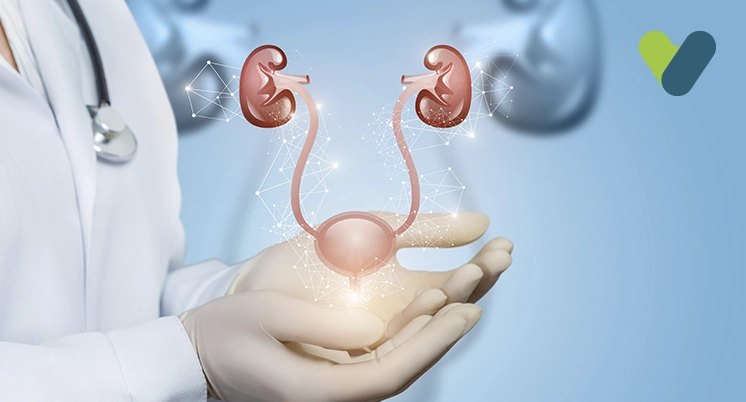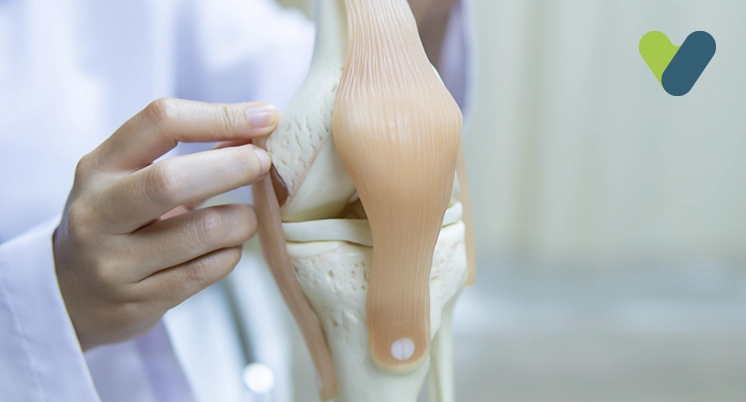What is a vesicovaginal fistula (VVF)?
A vesicovaginal fistula (VVF) is an unwanted opening that forms between the urinary bladder and the vagina. This hole can result in urinary incontinence and continuous urine leakage into the vagina from the bladder. The condition is serious and affects a person's quality of life. Living with constant, unpleasant urinary leakage can be distressing and lead to awkward situations.
Vesicovaginal fistulas are often a complication that occur after any type of gynaecologic surgery. Since the bladder is directly above the vagina, vaginal surgery can result in a vesicovaginal fistula. The following surgeries can cause this problem:
- Bladder repair (cystocele)
- Hysterectomy (uterine removal)
- Urinary incontinence treatment (sling procedures)
Radiation treatment for gynaecologic cancer is another cause of vesicovaginal fistula. Radiation results in progressive damage, and these fistulas can develop several years after the treatment. Recurrent urinary tract infections (UTIs) can also cause VVF, though this is extremely rare.
Other possible causes include:
- Injury during labour and delivery (e.g., assisted vaginal deliveries involving instruments)
- Infections and inflammatory conditions
- Foreign objects (e.g., pessaries)
- Vaginal laser procedures
- Sexual violence and trauma
What are the signs and symptoms of a vesicovaginal fistula (VVF)?
Constant vaginal discharge and discomfort during vaginal intercourse are the most common symptoms of VVF. However, if the fistula is small, the only symptom may be a watery discharge after urination.
Other signs of VVF include:
- Pain in the abdomen
- Fever
- Diarrhoea
- Nausea
- Vomiting
- Unexplained weight loss
What is a vesicovaginal fistula (VVF) repair surgery?
The VVF operation is a female-specific procedure that is used as an effective and sustainable treatment for vesicovaginal fistula.
The surgical intervention that is used to remove or close a fistula between the vagina and bladder is known as vesicovaginal fistula repair. Based on the extent of the fistula, the leak may be as small as a few droplets or as large as a steady stream. Regardless of the leak's size, it can make everyday activities and social interactions extremely difficult.
Why are VVF repairs done?
The VVF fistula can result in an uncontrolled flow of urine via the vagina. It can also be painful and raise the risk of infection. To alleviate symptoms, the fistula needs to be closed surgically.
VVF also reduces a woman's quality of life by causing mental distress, social isolation, and stigma. The surgery can effectively address VVF while also improving women’s symptoms and quality of life.
What to expect before vesicovaginal fistula surgery?
Before the doctor suggests a VVF operation, the patient needs to undergo a set of diagnostic tests, including:
- Pelvic examination: The doctor will check for any for inflammation and other abnormalities to help determine the best surgical strategy for the repair.
- Imaging tests: A pelvis X-ray, a CT scan, and an MRI, can assess how the uterus and bladder appear and to narrow down the location of the fistula or hole.
- Cystoscopy: A cystoscopy can assist in identifying the exact location of the VVF. This can help with treatment planning.
- Double dye test: The bladder is loaded with a blue-dyed solution, and a tampon is placed into the vagina. If a VVF is present, the tampon turns blue.
How to prepare for the VVF repair surgery?
The health professional will go over how to prepare for the surgical procedure with the patients. Some of the instructions can be:
- To refrain from drinking or eating anything the day before surgery.
- To take or avoid certain medications on the day of the surgery.
- Plan for someone to drive them home and accompany them after the surgery.
What to expect during the VVF surgery?
The VVF repair surgery can be performed either vaginally or through an abdominal incision. During surgery:
- The surgery is an in-patient procedure and can take between 1 and 3 hours, depending on its complexity.
- The patient will be given general anaesthesia to keep them asleep and pain-free.
- To help prevent infection, patients may be given antibiotics.
- To inspect the location of the fistula, the surgeon may introduce a scope through the urethra. A stent will protect each ureter during the surgery.
- An incision will be made around the fistula by the surgeon. The fistula would be sutured or cut out. The bladder and vaginal outer walls will be separated. The surgeon will use stitches to close the incision. To help prevent infection, bandages soaked in antibiotics may be put in the vagina.
If the surgery is performed through the belly:
- The surgeon will cut an incision beneath the belly button. The bladder wall will be cut away from the vagina, and the fistula will be removed.
- Before closing the incision, the surgeon may insert a suprapubic catheter through the abdomen and then into the bladder. This catheter serves as a drain for the urine and can be kept in place for a maximum of three weeks.
- Patients may also require a drain to remove the excess blood and fluid. The cut will be stitched up.
What to expect after the VVF repair surgery?
- After the surgery, patients are kept in the hospital for about 1 to 3 days for simple repairs and about 3-5 days for complex repairs. During the hospitalization, nurses and doctors will monitor their vitals and change the dressing as needed. Nurses will also take care of the catheter to prevent any infections.
- Initially, after the surgery, it is evident that there will be some amount of pain. Patients may be prescribed pain relievers depending on the intensity of the pain.
- At home, patients are expected to take care of the wound, keep it clean, and avoid certain physical activities that can affect it.
What are the risks associated with the VVF repair?
- Patients might bleed more than usual or develop an infection.
- The ureters may get damaged.
- Individuals might experience vaginal bleeding and bladder spasms.
- Patients may be unable to completely empty the bladder or develop bladder stones.
- Patients may still experience leaky urine or have frequent urge to urinate even after surgery.
- Surgery may reduce the size of the bladder or shorten the vaginal canal.
- Even if the surgery to remove the fistula is performed, a new fistula may develop.
When to contact the doctor?
It is essential for patients to keep track of their recovery once they are discharged from the hospital. Any problems should be reported to the doctor right away. Call the doctor when any of these symptoms arise:
• Increasing pain or pressure • Redness, bleeding, soreness, or discharge at or near the site of the incision • Urine frequency, appearance, odour, or amount changes • Urinary incontinence • Infection signs, such as fever or chills • Excessive blood in the urine
How much is the cost of VVF surgery in India?
The cost of VVF repair surgery in India can depend on a variety of factors, including the clinic or hospital where the operation is done, the surgeon's fees, the complexity of the surgery, and any other medical costs involved with the patient's care; however, compared to other countries, VVF repair surgery in India is relatively inexpensive, and the overall cost is likely to be much less than in other developed countries.
Takeaway
In conclusion, VVF repair surgery can be an efficient treatment option for vesicovaginal fistula patients. However, as with any surgical procedure, there are risks involved. Patients should carefully consider the potential advantages and disadvantages prior to actually deciding to undergo surgery.


